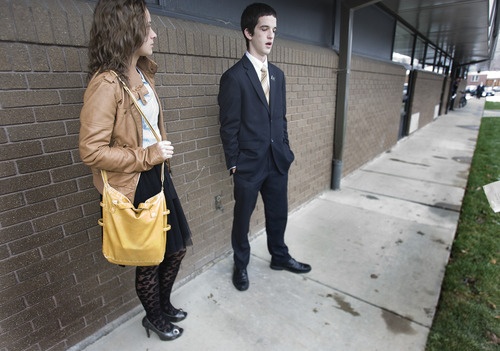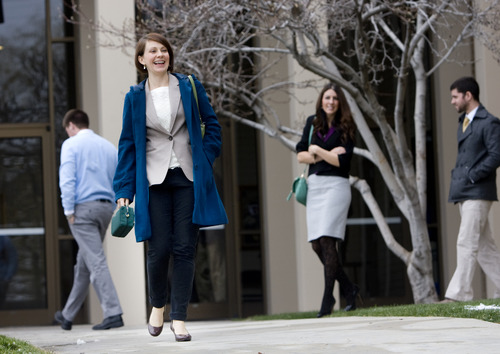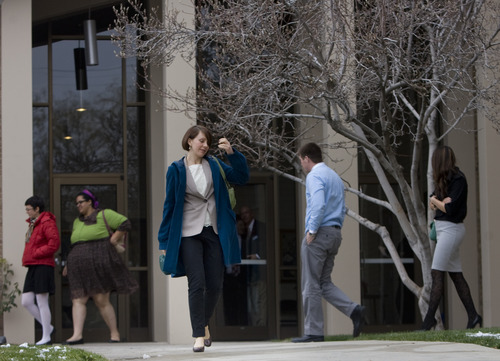This is an archived article that was published on sltrib.com in 2012, and information in the article may be outdated. It is provided only for personal research purposes and may not be reprinted.
Sunday's Wear Pants to Church Day did not signal the end of the world, but the event did launch a conversation that some members of The Church of Jesus Christ of Latter-day Saints believe to be important to the religion's relevance.
"It's not the pantspocalypse it was made out to be," said Murray resident Stephanie Lauritzen, who launched the idea online via an "All Enlist" Facebook page that went viral, gathering reactions worldwide both of disgust and support.
"We currently have 700 members, and we've only been live for a week and a half," Lauritzen said of those who stand in solidarity with the group's mission statement:
"We do not seek to eradicate the differences between women and men, but we do want the LDS Church to acknowledge the similarities. We believe that much of the cultural, structural and even doctrinal inequality that persists in the LDS Church today stems from the church's reliance on — and enforcement of — rigid gender roles that bear no relationship to reality."
Sunday afternoon, 28-year-old Julia Shumway wore fashionable black pants and dress shoes to her singles ward on A Street near downtown Salt Lake City. She was the lone female not to wear a skirt or dress.
"Hopeful," Shumway said of how she felt taking the pants plunge. "I felt exactly as welcomed at church as I do every other Sunday, and for me it was an affirmation that a dialogue can be had."
Shumway wrote about Wear Pants to Church Day on her blog, "Radically Amazed," and said she received a host of "worried and scolding comments" posted on her blog. Some feared the event was being staged as a protest.
"Instead it was just a peaceful manifestation of worship, and I think it opened a visual dialogue and an Internet dialogue that I hope will continue," Shumway said.
Some members of an LDS ward near 700 South and 700 East in Salt Lake City felt strongly that Sunday best for females involves skirts and dresses for those who have them.
"It shows something special about Sunday mornings, about coming to church and about respecting the buildings that have been dedicated to the Lord," said Steve Baxter, a south Salt Lake Valley resident who visits various wards with his wife, Afton Baxter.
"I think it enhances the feeling of reverence," Afton Baxter said of her shift from jeans to skirts on the Sabbath. "It's a different feeling from going grocery shopping or going to a movie. This needs to be a special part of our life that we can honor."
Both Baxters, longtime Mormons now in midlife, acknowledged that the "dress" code is unwritten.
"We've been given verbal guidelines that Sunday best is a white shirt and tie, and dresses for the ladies when we're going to the chapel," Steve Baxter said.
Afton Baxter said she simply feels different when she's wearing a dress or skirt.
"It's hard to invite the spirit on a Sunday if I might be dressing down," she said.
But on A Street, Cameron Diehl applauded Shumway for bucking the cultural norm, adding that he welcomed the church's slow but sure movement toward becoming more tolerant and progressive.
"The church allows for people to have their unique and different perspectives," Diehl said, "and if that means that people express that by wearing pants, I think that's perfectly acceptable."
Breeanne Martin, 25 and married, said she was the only woman wearing pants to her West Bountiful ward Sunday — and it was her first time doing so.
"I think it's important that we make space for women who are different," Martin said, noting "there were a lot of cries this week for people who don't like the church to leave."
"Mormonism can be a hard place for women who tend to be freethinking and nonconforming," Martin added.
West Valley City Mayor Mike Winder voiced his support by tweeting, "We had a beautiful invocation at church today by a great sister wearing pants."
"I'm the last one to comment on women's fashion," Winder said by phone, "but when I see the secretary of state wearing pantsuits in the most formal of settings, I see that it is one of several ways to dress up and show respect."
Men who agreed with the movement's vision were urged to wear purple shirts, ties, socks or ribbons — a color associated with the women's suffrage movement.
"I saw one purple tie, on the stand. And that makes me feel good," said Lauritzen, a young mother who darted home between church sessions Sunday to lay her baby down for a nap.
"The church does a great job respecting and honoring the role of motherhood, and we appreciate that," Lauritzen said. "They tell us we're incredible in our sacrifices as mothers and wives. But we're also human, and the humanity in us tells us we want something more from our religious experience.











